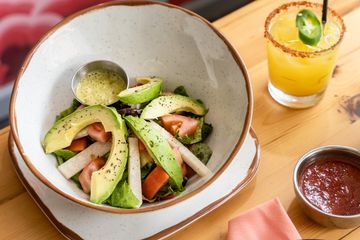Enjoy vibrant hand crafted margarita creations that enhance your dining experience
What Are the Essential Meals That Define Mexican Cuisine?
Mexican food is a lively reflection of its cultural heritage, identified by a range of vital dishes. Tacos, mole, pozole, tamales, and ceviche each inform an one-of-a-kind story of tradition and taste. These foods not only please the taste buds however also personify the spirit of area and event. Understanding their significance discloses much regarding Mexico's culinary identification. What exists underneath the surface of these beloved meals?

Tacos: The Quintessential Street Food
Tacos are typically considered the ultimate street food of Mexico, commemorated for their convenience and abundant tastes. They consist of an easy tortilla, normally made from corn or flour, full of a range of components that can range from barbequed meats to vegetables. This versatility enables numerous regional variants, each showcasing neighborhood flavors and practices.
Popular dental fillings consist of carne asada, carnitas, and pollo, typically gone along with by fresh garnishes like cilantro, onions, and lime. Road vendors adeptly prepare and offer tacos, making them a convenient and affordable choice for residents and visitors alike.
The experience of consuming tacos is boosted by the lively ambience of Mexican roads, where the aroma of flavors and sizzling meat loads the air. This renowned meal not only satisfies appetite but also represents the cultural richness of Mexico, mirroring its background, neighborhood, and cooking creativity.
Mole: A Symphony of Flavors
Mole symbolizes the intricacy and depth of Mexican cuisine, supplying an abundant tapestry of flavors that captivate the taste buds. This sauce, usually made with a mix of chilies, seasonings, nuts, and chocolate, showcases the virtuosity and cultural heritage of Mexico. Each area flaunts its distinct analysis, with variants such as mole poblano and mole negro, mirroring regional ingredients and practices.
The preparation of mole is a complex procedure, needing ability and perseverance as the active ingredients are meticulously toasted, ground, and simmered to perfection. The resulting sauce can vary from tasty to sweet, with layers of taste that advance with each bite. Commonly offered over chicken or turkey, mole goes beyond mere nourishment, often gracing special celebrations and parties. Its dynamic color and complex account represent the abundant cooking identification of Mexico, making it a vital meal that reverberates with both visitors and residents alike.
Pozole: A Hearty Tradition
Although frequently taken pleasure in throughout cheery events, pozole is a dish deeply rooted in Mexican custom, embodying both cultural importance and common spirit. This passionate soup, made mainly from hominy, meat-- generally pork or hen-- and an abundant broth, has old beginnings that map back to pre-Columbian people. Generally planned for events such as Mexican Independence Day and wedding events, pozole goes beyond simple nutrition, cultivating a sense of unity amongst those who partake.
The meal can be found in different local variants, including pozole rojo, verde, and blanco, each differentiated by its one-of-a-kind active ingredients and flavor profiles. Toppings such as shredded cabbage, radishes, avocado, and lime enhance the meal, allowing for personal expression. Beyond its tasty high qualities, pozole serves as a symbol of heritage, connecting generations through shared dishes and cooking practices. Its prep work frequently ends up being a common event, enhancing bonds among household and pals, making it a true symbol of Mexican friendliness.
Tamales: Wrapped crazy
Tamales hold an unique location in Mexican cuisine, similar brunch places to pozole, celebrating practice and community. These delightful parcels of masa, or corn dough, are usually loaded with a range of ingredients, including meats, vegetables, fruits, or cheeses, and after that wrapped in corn husks or banana leaves before being steamed to excellence - best mexican westchester NY. The preparation of tamales often involves family celebrations, where generations integrated to share the labor of mixing, filling up, and wrapping, reinforcing their relevance as a public meal
Tamales are especially prominent throughout festive celebrations, such as Christmas and Día de los Muertos, signifying a connection to cultural heritage. They are not simply food; they symbolize love, care, and the giving of culinary skills. Each area in Mexico boasts its very own distinct variants, showcasing neighborhood flavors and traditions, making tamales a cherished staple that transcends generations and joins people across the country.
Ceviche: A Fresh Coastal Delight
Ceviche, a lively meal rooted in the coastal regions of Mexico, showcases the quality of the ocean's bounty. Traditionally made with raw fish marinaded in citrus juices, especially lime, ceviche is celebrated for its invigorating taste account. The level of acidity from the lime "cooks" the fish, leading to a tender appearance that pairs perfectly with the intense ingredients often consisted of, such as diced tomatoes, onions, cilantro, and chili peppers.
Areas like Baja The Golden State and the Yucatán Peninsula have their own distinct versions, incorporating regional seafood such as shrimp, octopus, or scallops. Offered chilled, ceviche is commonly come with by tortilla chips or tostadas, enhancing its appeal as a prominent appetiser or light meal. This meal not just mirrors the abundant marine life of Mexico yet likewise highlights the cultural significance of fresh, neighborhood ingredients in Mexican gastronomy. Ceviche stays a cherished depiction of coastal culinary customs.
Regularly Asked Inquiries
What Are the Key Ingredients in Conventional Mexican Cuisine?
Secret ingredients in typical Mexican cuisine include corn, beans, chilies, tomatoes, and avocados. best mexican westchester NY. These staples develop the foundation of several meals, mirroring the vivid flavors and varied cooking heritage of Mexico's abundant gastronomic landscape
Just How Has Mexican Cuisine Progressed Gradually?
Mexican food has progressed with centuries, affected by native practices, Spanish emigration, and worldwide components. This dynamic blend has actually resulted in varied regional flavors, methods, and recipes that continue to adapt and innovate with my sources contemporary culinary trends.

What Prevail Dietary Restrictions in Mexican Cooking?
Usual nutritional constraints in Mexican cooking consist of veganism, gluten, and vegetarianism intolerance. Many standard meals can be adapted to suit these choices, guaranteeing that tastes remain dynamic while valuing private nutritional needs and social methods.
Just How Do Regional Variations Impact Mexican Meals?
Regional variants substantially influence Mexican meals through local components, typical food preparation techniques, and cultural impacts. Each region's one-of-a-kind climate and carry out near me history contribute distinctive tastes, methods, and dishes, leading to a rich cooking variety across the country.
What Beverages Pair Best With Mexican Food?
Conventional Mexican cuisine pairs well with beverages like horchata, aguas frescas, and tequila. Craft beers and mezcal also enhance the tastes, improving the eating experience with their unique accounts and invigorating qualities.
Mexican cuisine is a vibrant representation of its social heritage, defined by a variety of essential meals. Mole embodies the complexity and deepness of Mexican food, supplying a rich tapestry of tastes that mesmerize the taste. Typically appreciated throughout cheery celebrations, pozole is a recipe deeply rooted in Mexican custom, symbolizing both cultural significance and public spirit. Mexican cuisine has advanced with centuries, influenced by aboriginal customs, Spanish emigration, and international ingredients. Regional variations considerably affect Mexican dishes through regional ingredients, traditional food preparation approaches, and cultural impacts.